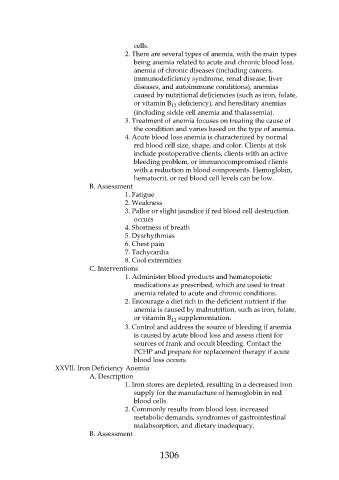Page 1306 - Saunders Comprehensive Review For NCLEX-RN
P. 1306
cells.
2. There are several types of anemia, with the main types
being anemia related to acute and chronic blood loss,
anemia of chronic diseases (including cancers,
immunodeficiency syndrome, renal disease, liver
diseases, and autoimmune conditions), anemias
caused by nutritional deficiencies (such as iron, folate,
or vitamin B deficiency), and hereditary anemias
12
(including sickle cell anemia and thalassemia).
3. Treatment of anemia focuses on treating the cause of
the condition and varies based on the type of anemia.
4. Acute blood loss anemia is characterized by normal
red blood cell size, shape, and color. Clients at risk
include postoperative clients, clients with an active
bleeding problem, or immunocompromised clients
with a reduction in blood components. Hemoglobin,
hematocrit, or red blood cell levels can be low.
B. Assessment
1. Fatigue
2. Weakness
3. Pallor or slight jaundice if red blood cell destruction
occurs
4. Shortness of breath
5. Dysrhythmias
6. Chest pain
7. Tachycardia
8. Cool extremities
C. Interventions
1. Administer blood products and hematopoietic
medications as prescribed, which are used to treat
anemia related to acute and chronic conditions.
2. Encourage a diet rich in the deficient nutrient if the
anemia is caused by malnutrition, such as iron, folate,
or vitamin B supplementation.
12
3. Control and address the source of bleeding if anemia
is caused by acute blood loss and assess client for
sources of frank and occult bleeding. Contact the
PCHP and prepare for replacement therapy if acute
blood loss occurs.
XXVII. Iron Deficiency Anemia
A. Description
1. Iron stores are depleted, resulting in a decreased iron
supply for the manufacture of hemoglobin in red
blood cells.
2. Commonly results from blood loss, increased
metabolic demands, syndromes of gastrointestinal
malabsorption, and dietary inadequacy.
B. Assessment
1306

